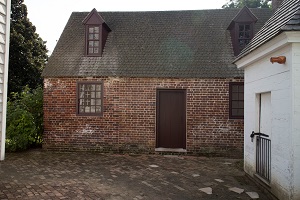Oxford Tree-Ring Laboratory - Virginia
Virginia

The Brush-Everard House, Williamsburg, VA (37.273216, -76.701640)
Felling Dates: Winter 1718/19 and Spring 1719
Stair trimmer at landing level 1718(C); Cleats 1718(C), 1698; Treads/boards (1/5) 1718(½C); Strings 1693(+7 heartwood rings NM), 1663; Landing joists (2/3) 1701, 1695. Site Master 1593-1718 BEH (t = 5.4 VAPINE; 5.1 PHWV; 4.9 ATHx1; 4.7 WVVAP; 4.7 TUVA).
The Thomas Everard House, on Palace Green, is one of Williamsburg’s most intact buildings from the colonial period. As restored, it is a 1-1/2 story, five-bay, frame house with a centre-passage, single-pile main block built in 1718 and a rear wing to the north-east built a couple of years later. It has a well-appointed interior, with wainscoting in all three front rooms and a generous staircase with ornately carved brackets. The Everard House was built for gunsmith John Brush and renovated by Thomas Everard in the 1750s and 1760s. Between these two major building episodes, however, the house’s complex evolution has been a long-standing puzzle. In the 1940s, Albert Kocher and Howard Dearstyne hypothesised that the stair and passage panelling were later additions, based on their dissimilarity to the panelling in the two main rooms. More recently, Willie Graham and Mark R. Wenger confirmed that the stair and its panelling were indeed not original, noting that the stair blocks an original door opening at the back of the passage. As important, they found no evidence for an earlier stair, suggesting that access to the second floor was initially via a steep ladder, rising from the rear. The date of the stair, however, has been impossible to determine with any precision. Paint evidence indicates that it was in place, and painted red-brown, before Thomas Everard’s first remodelling campaign of the 1750s. The similarity of its brackets to those at Tuckahoe, dated 1733, and Carter’s Grove, dated 1755, would seem to suggest that it was installed no earlier than the 1730s. If this were true, however, the passage would have remained unfinished and without a permanent stair for at least a decade, and perhaps as much as a quarter century. The dendrochronology has shown that the staircase was in fact installed as part of the same phase of construction as the northern rear wing in about 1720, completing the ensemble.
Miles, D H, and Worthington, M J, 2006 “The Tree-Ring Dating of Staircase Timbers from the Brush-Everard House, Williamsburg, Virginia ”, ODL unpubl rep 2006/49 Oxford Dendrochronology Laboratory Interim Report 2006/58
Oxford
Tree-Ring
Laboratory
The Oxford Tree-Ring Laboratory provides cutting-edge commercial dendrochronological services to homeowners, architectural historians, and cultural resource managers. READ MORE
Contact Information
Oxford Tree-Ring Laboratory
ProprietorsMichael Worthington
Jane Seiter, Ph.D
25 E. Montgomery St.
Baltimore, MD 21230
410-929-1520